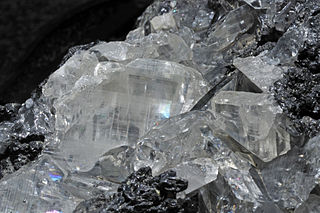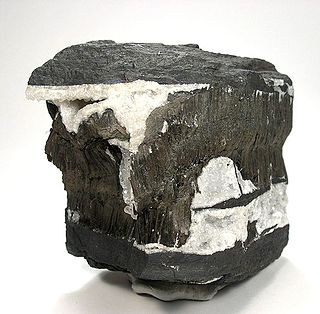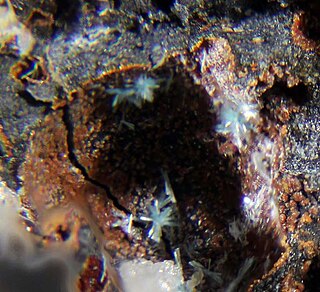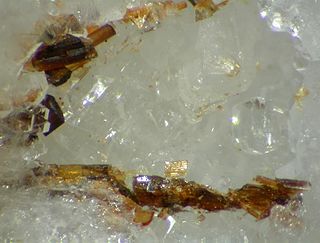Related Research Articles

Lead(II) sulfate (PbSO4) is a white solid, which appears white in microcrystalline form. It is also known as fast white, milk white, sulfuric acid lead salt or anglesite.

Anglesite is a lead sulfate mineral with the chemical formula PbSO4. It occurs as an oxidation product of primary lead sulfide ore, galena. Anglesite occurs as prismatic orthorhombic crystals and earthy masses, and is isomorphous with barite and celestine. It contains 74% of lead by mass and therefore has a high specific gravity of 6.3. Anglesite's color is white or gray with pale yellow streaks. It may be dark gray if impure.

Vivianite (Fe(II)
3(PO
4)
2·8H
2O) is a hydrated iron(II) phosphate mineral found in a number of geological environments. Small amounts of manganese Mn2+, magnesium Mg2+, and calcium Ca2+ may substitute for iron Fe2+ in its structure. Pure vivianite is colorless, but the mineral oxidizes very easily, changing the color, and it is usually found as deep blue to deep bluish green prismatic to flattened crystals. Vivianite crystals are often found inside fossil shells, such as those of bivalves and gastropods, or attached to fossil bone. Vivianite can also appear on the iron coffins or on the corpses of humans as a result of a chemical reaction of the decomposing body with the iron enclosure.

Barytocalcite is an anhydrous barium calcium carbonate mineral with the chemical formula BaCa(CO3)2. It is trimorphous with alstonite and paralstonite, that is to say the three minerals have the same formula but different structures. Baryte and quartz pseudomorphs after barytocalcite have been observed.

Leadhillite is a lead sulfate carbonate hydroxide mineral, often associated with anglesite. It has the formula Pb4SO4(CO3)2(OH)2. Leadhillite crystallises in the monoclinic system, but develops pseudo-hexagonal forms due to crystal twinning. It forms transparent to translucent variably coloured crystals with an adamantine lustre. It is quite soft with a Mohs hardness of 2.5 and a relatively high specific gravity of 6.26 to 6.55.

Todorokite is a complex hydrous manganese oxide mineral with generic chemical formula (Na,Ca,K,Ba,Sr)
1-x(Mn,Mg,Al)
6O
12·3-4H
2O. It was named in 1934 for the type locality, the Todoroki mine, Hokkaido, Japan. It belongs to the prismatic class 2/m of the monoclinic crystal system, but the angle β between the a and c axes is close to 90°, making it seem orthorhombic. It is a brown to black mineral which occurs in massive or tuberose forms. It is quite soft with a Mohs hardness of 1.5, and a specific gravity of 3.49 – 3.82. It is a component of deep ocean basin manganese nodules.

Tsumcorite is a rare hydrated lead arsenate mineral that was discovered in 1971, and reported by Geier, Kautz and Muller. It was named after the TSUMeb CORporation mine at Tsumeb, in Namibia, in recognition of the Corporation's support for mineralogical investigations of the orebody at its Mineral Research Laboratory.

Köttigite is a rare hydrated zinc arsenate which was discovered in 1849 and named by James Dwight Dana in 1850 in honour of Otto Friedrich Köttig (1824–1892), a German chemist from Schneeberg, Saxony, who made the first chemical analysis of the mineral. It has the formula Zn3(AsO4)2·8H2O and it is a dimorph of metaköttigite, which means that the two minerals have the same formula, but a different structure: köttigite is monoclinic and metaköttigite is triclinic. There are several minerals with similar formulae but with other cations in place of the zinc. Iron forms parasymplesite Fe2+3(AsO4)2·8H2O; cobalt forms the distinctively coloured pinkish purple mineral erythrite Co3(AsO4)2·8H2O and nickel forms annabergite Ni3(AsO4)2·8H2O. Köttigite forms series with all three of these minerals and they are all members of the vivianite group.

Carminite (PbFe3+2(AsO4)2(OH)2) is an anhydrous arsenate mineral containing hydroxyl. It is a rare secondary mineral that is structurally related to palermoite (Li2SrAl4(PO4)4(OH)4). Sewardite (CaFe3+2(AsO4)2(OH)2) is an analogue of carminite, with calcium in sewardite in place of the lead in carminite. Mawbyite is a dimorph (same formula, different structure) of carminite; mawbyite is monoclinic and carminite is orthorhombic. It has a molar mass of 639.87 g. It was discovered in 1850 and named for the characteristic carmine colour.
Scandiobabingtonite was first discovered in the Montecatini granite quarry near Baveno, Italy in a pegmatite cavity. Though found in pegmatites, the crystals of scandiobabingtonite are sub-millimeter sized, and are tabular shaped. Scandiobabingtonite was the sixth naturally occurring mineral discovered with the rare earth element scandium, and grows around babingtonite, with which it is isostructural, hence the namesake. It is also referred to as scandian babingtonite. The ideal chemical formula for scandiobabingtonite is Ca2(Fe2+,Mn)ScSi5O14(OH).

Mammothite is a mineral found in the Mammoth mine in Tiger, Arizona and also in Laurium, Attika, Greece. This mineral was named in 1985 by Donald R. Peacor, Pete J. Dunn, G. Schnorrer-Köhler, and Richard A. Bideaux, for the Mammoth vein (one of the two main veins in the mine) and the town of Mammoth, Arizona, which was named for the mine. The mammothite that is found in Arizona exist as euhedral crystals imbedded in micro granular, white colored anglesite with a saccharoidal texture. The associated minerals include phosgenite, wulfenite, leadhillite and caledonite. In Greece, the mammothite exists as small euhedral crystals and also as microscopic rock cavities lined with projecting crystals within the slags. The associated minerals here are cerussite, phosgenite and matlockite. The ideal chemical formula for mammothite is Pb6Cu4AlSb5+O2(OH)16Cl4(SO4)2.
Lahnsteinite is a basic sulfate mineral first discovered in the Friedrichssegen Mine, Germany in a goethite cavity. Though found in goethite, the crystals of Lahnsteinite are few millimeters in size, and are tabular shaped. Lahnsteinite was the first mineral discovered in the Lahn Valley deposits. The empirical formula for lahnsteinite is (Zn3.3,Fe0.27,Cu0.11)3.91(S0.98O4)(OH)5*3H2.10O.

Lemanskiite is a mineral that was first discovered in a mine at Abundancia mine, El Guanaco mining district, Chile, with the ideal formula of NaCaCu5(AsO4)4Cl·3H2O. Originally, this mineral was discovered as being dimorphus with lavendulan, but in 2018 it was revised to only have 3 water molecules. Lemanskiite typically occurs as rosette-shaped aggregates of thin lamellar or needle-shaped aggregates, such as lammerite. Lemanskiite is dark sky blue with a light blue streak, it is brittle with an excellent cleavage plane. It was found on a dumping site in the abandoned Abundancia mine, El Guanaco mining district, Region II, Antofagasta Province, Chile The new mineral has been named after Chester S. Lemanski, Jr. This mineral and name were then approved by the Commission on New Minerals and Mineral Names of the International Mineralogical Association.

Malhmoodite is a phosphate mineral first discovered at a mine called Union Carbide in Wilson Springs, Arkansas, United States. This mine is 10 km west of Magnet Cove, an alkaline igneous complex, and Union Carbide is in a contact region of alkalic igneous rocks and surrounding sedimentary rocks. The mineral has been approved by the Commission on New Minerals and Mineral Names, IMA, to be named for the late Bertha K. Malhmood, the Administrative Assistant of the Branch of Analytical Laboratories, U.S. Geological Survey.
Chukanovite is an iron(II) hydroxide-carbonate mineral with the ideal chemical formula Fe+22(CO3)(OH)2. It is a member of the rosasite mineral group and crystalizes in the monoclinic crystal system. Upon initial crystallization, it is typically pale green to colorless, but it takes on a brownish green hue after being altered at the surface. As a weathering product of meteoritic iron, chukanovite is a relatively uncommon mineral on Earth, having only been discovered in the year 2000. However, it is commonly formed artificially as a corrosion byproduct through the manufacturing of sand-deposited carbon steel.
Northstarite is an immensely rare lead-tellurite-thiosulfate mineral with an ideal formula of Pb6(Te4+ O3)5(S6+O3S2-). Northstarite was first discovered in 2019 by Charles Adan in the North Star Mine of the Tintic Mining District, Juab County, Utah, USA. Northstarite received its name after this type locality where it was originally discovered, the North Star Mine. Northstarite is the fourth thiosulfate mineral that exists on Earth, and although all thiosulfates have essential lead components, northstarite is the first thiosulfate species containing groups of both thiosulfate and tellurite (Te4+O3).

Vigezzite is a variant of the mineral aeschynite containing calcium, cerium, niobium, tantalum, and titanium. It was first discovered near Orcesco, Valle Vigezzo, Provo Novara, Northern Italy, in cavities of an albitic rock. The crystals of Vigezzite are flat prismatic crystals up to 2-3 mm length of an orange-yellow color.The name Vigezzite was chosen to draw attention to the locality that has produced the first occurrence of a Ca-Nb-Ta-mineral with Nb dominance over Ta, crystallizing with the aeschynite structure. The ideal chemical formula for vigezzite is (Ca,Ce),(Nb,Ta,Ti)2O6
Raygrantite is a mineral first discovered in Big Horn Mountains, Maricopa County, Arizona, US. More specifically, it is located in the evening star mine, which is a Cu, V, Pb, Ag, Au, and W mine. Raygrantite is a member of the iranite mineral group, which consists of hemihedrite, iranite, and raygrantite. This mineral received its name in honor of Raymond W. Grant, a retired professor who primarily focused on the minerals of Arizona. The typical crystal structure of raygrantite is bladed with parallel striations to the C axis. Its ideal chemical formula is Pb10Zn(SO4)6(SiO4)2(OH)2. The IMA (International Mineralogical Association) approved raygrantite in 2013, and the first publication regarding this mineral was put forth in 2017.
Belloite is a Halide mineral first discovered in the Rio Tinto Mine in Sierra Gorda, Antofagasta, Chile in 1998. Belloite has the ideal chemical formula of Cu(OH)Cl. The mineral has been approved by the Commission on New Minerals and Mineral Names, IMA, to be named belloite, after Andrés de Jesús María y José Bello López, the founder of the Universidad de Chile. Samples of belloite are preserved in the collection of the Mineralogical Museum in Hamburg, Germany.
Ophirite is a tungstate mineral first discovered in the Ophir Hill Consolidated mine at Ophir district, Oquirrh Mountains, Tooele County, Utah, United States of America. It was found underground near a calcite cave in one veinlet, six centimeters wide by one meter long, surrounded by different sulfides. Before the closing of the mine in 1972, it was dominated by sulfide minerals, and the Ophir district was known for being a source of zinc, copper, silver, and lead ores. The crystals are formed as tablets. It is the first known mineral to contain a heteropolyanion, a lacunary defect derivative of the Keggin anion. The chemical formula of ophirite is Ca2Mg4[Zn2Mn3+2(H2O)2(Fe3+W9O34)2] · 46•H2O. The mineral has been approved by the Commission on New Minerals and Mineral Names, IMA, to be named ophirite for its type locality, the Ophir Consolidated mine.
References
- ↑ Warr, L.N. (2021). "IMA–CNMNC approved mineral symbols". Mineralogical Magazine. 85 (3): 291–320. Bibcode:2021MinM...85..291W. doi: 10.1180/mgm.2021.43 . S2CID 235729616.
- 1 2 3 4 5 6 7 8 9 Paar, W.H., R.S.W. Braithwaite, T.T. Chen, and P. Keller (1984) A new mineral, scotlandite (PbSO3) from Leadhills, Scotland: the first naturally occurring sulphite. Mineral. Mag., 48, 283–288.
- 1 2 3 4 Hudson Institute of Mineralogy, 2017, Scotlandite: https://www.mindat.org/min-3597.html (accessed November 2017)
- 1 2 Borthwick, C.W., 1992, Leadhills and Wanlockhead - an excursion: http://earthwise.bgs.ac.uk/index.php/Leadhills_and_Wanlockhead_-_an_excursion (accessed November 2017)
- 1 2 Pertlik, F. & Zemann, J. TMPM Tschermaks Petr. Mitt. (1985) 34: 289. https://doi.org/10.1007/BF01082968 (accessed December 2017)